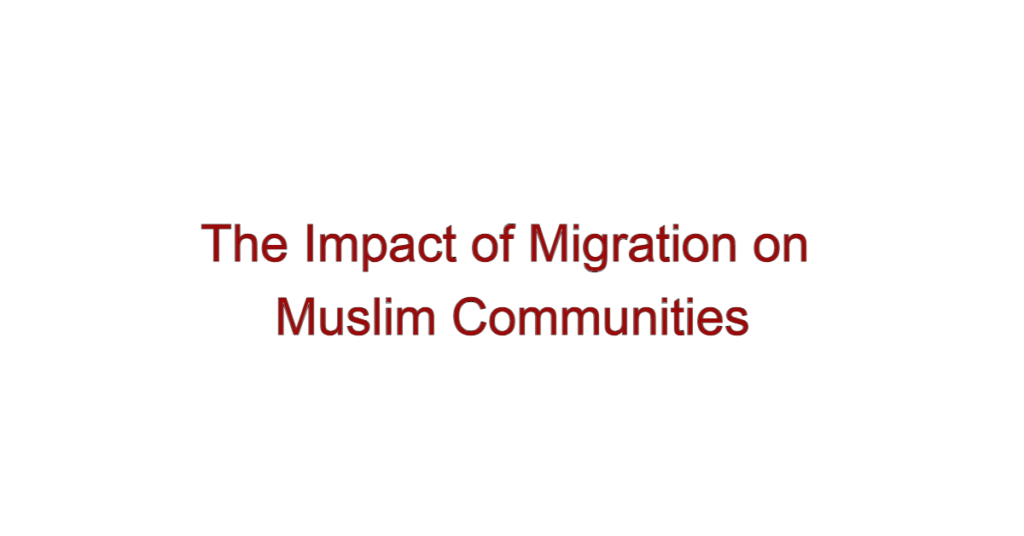Migration has always been a significant phenomenon, shaping the cultural, economic, and social landscapes of nations across the globe. In recent decades, the impact of migration on Muslim communities has been profound, influencing everything from religious practices to social integration, and even the global perception of Islam. As millions of Muslims migrate for reasons ranging from economic opportunities to fleeing conflict, the dynamics within Muslim communities and their interactions with host societies have undergone considerable transformation.
The Drivers of Migration Among Muslims
Muslim migration is driven by a variety of factors, including economic opportunities, political instability, armed conflicts, and environmental challenges. Regions such as the Middle East, South Asia, and parts of Africa have witnessed significant outflows of Muslim populations due to war, persecution, and economic hardship. For many, migration offers a chance for safety, stability, and a better quality of life, but it also brings challenges that affect both the migrants and the communities they join.
Challenges of Identity and Integration
One of the most significant impacts of migration on Muslim communities is the challenge of maintaining religious and cultural identity while integrating into new, often non-Muslim majority societies. In countries across Europe, North America, and Australia, Muslim migrants often find themselves navigating a delicate balance between preserving their religious practices and adapting to the norms of their host countries.
This balancing act can lead to generational differences within families, where younger members may adopt more of the host country’s culture, sometimes causing tensions with older, more traditional members. Additionally, Muslim communities often face challenges related to Islamophobia, discrimination, and misunderstanding of Islamic practices, which can hinder their ability to fully integrate into society.
Economic Contributions and Social Dynamics
Despite the challenges, Muslim migrants contribute significantly to the economies of their host countries. They often take on jobs that are vital to the economy, particularly in sectors such as healthcare, construction, and services. In many cases, they also start businesses, creating jobs and contributing to economic growth.
Moreover, migration has led to the development of vibrant Muslim communities in many parts of the world. These communities often establish mosques, schools, and cultural centers, which not only serve as places of worship but also as hubs for cultural exchange and social support. Through these institutions, Muslim migrants are able to maintain their cultural heritage while also participating in the broader society.
Influence on Global Muslim Identity
The migration of Muslims has also had a significant impact on the global Muslim identity. As Muslims from different cultural and ethnic backgrounds come together in new environments, there is often a blending of traditions, leading to a more globalized understanding of Islam. This has led to the emergence of new forms of Islamic expression, where traditional practices are adapted to fit new cultural contexts.
For instance, in Western countries, there has been a rise in Islamic cultural products such as halal food markets, Islamic fashion, and media catering to Muslim audiences. These developments reflect the growing presence and influence of Muslim communities in these regions and contribute to the evolving identity of Muslims globally.
The Role of Islamic Organizations
Islamic organizations play a crucial role in helping Muslim migrants adjust to their new environments. These organizations provide religious guidance, social services, and support networks that are essential for the well-being of migrants. They also advocate for the rights of Muslim communities, working to combat discrimination and promote understanding between different cultural and religious groups.
Through these efforts, Islamic organizations help facilitate the integration of Muslim migrants while also ensuring that they can practice their religion freely and maintain their cultural identities.
Conclusion
The impact of migration on Muslim communities is multifaceted, affecting everything from identity and integration to economic contribution and global Islamic practices. While challenges such as discrimination and cultural adaptation exist, the resilience and contributions of Muslim migrants have helped shape diverse and dynamic communities in their host countries. As the global landscape continues to change, the experiences of Muslim migrants will remain a vital part of the broader narrative of migration and its impact on societies worldwide.
4o

